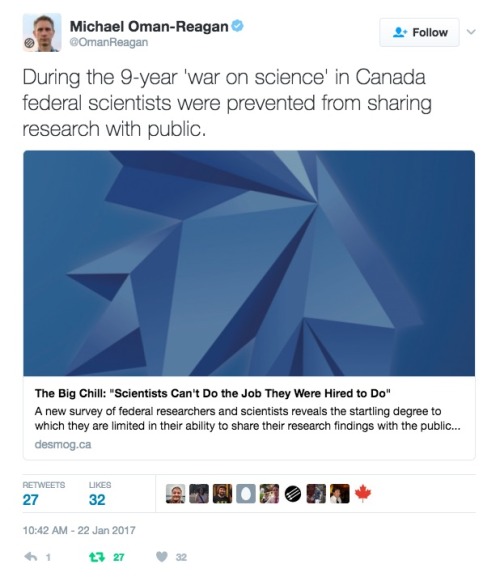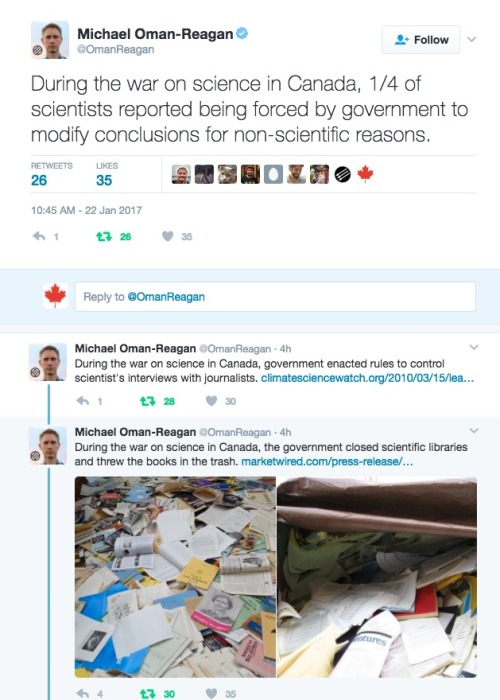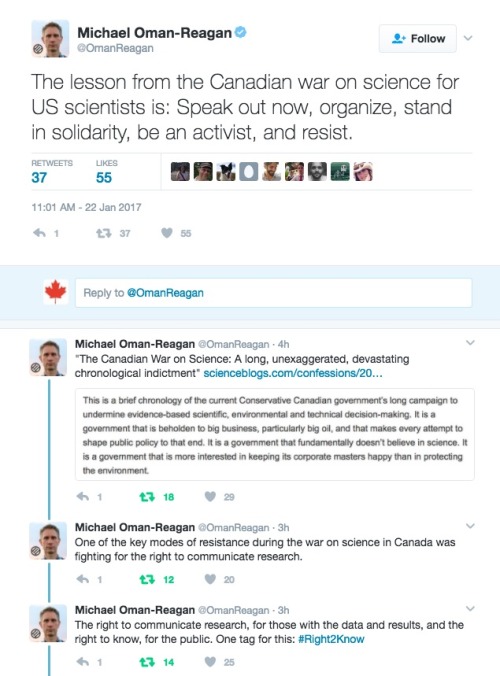Feeling A Little Small? Well In The Context Of The Cosmos, We Are Small. We May Just Be Little Guys Living








Feeling a little small? Well in the context of the cosmos, we are small. We may just be little guys living on a speck of dust, afloat in a staggering immensity…
…but we dont think small.
More Posts from Contradictiontonature and Others









A required read from Michael Oman-Reagan.
This is all true. This all happened in Canada, and its very likely it will happen in the USA under Trump and be worse than Harper’s crackdown on Science ever was.
Links cited in this twitter essay:
The Big Chill: “Scientists Can’t Do the Job They Were Hired to Do”
More than 1000 Jobs Lost, Climate Program Hit Hard in Coming Environment Canada Cuts
Harper Government Trashes Another Federal Science Library
Federal scientists closely monitored during polar conference
Science Silenced: US Scientist Caught in Canadian Muzzle Climate-change scientists feel ‘muzzled’ by Ottawa: Documents
The Canadian War on Science: A long, unexaggerated, devastating chronological indictment
http://ourrighttoknow.ca/
http://write2know.ca/
https://evidencefordemocracy.ca


Today is World Anaesthesia Day! Here’s a look at the chemistry behind a range of anaesthetics. More info here and here.

Maryam Mirzakhani was an Iranian mathematician and a professor of mathematics at Stanford University. She was the first-ever female winner of the prestigious Fields Medal prize and the first Iranian to be honoured with the award.
Mirzakhani was born in Tehran, Iran. She attended Farzanegan School, which was part of the National Organization for Development of Exceptional Talents. In both 1994 and 1995 she won the International Mathematical Olympiads for high-school students. In the 1995 International Mathematical Olympiad, she became the first Iranian student to achieve a perfect score and to win two gold medals.
Mirzakhani continued her education at Sharif University of Technology in Tehran, where she earned a BSc in Mathematics. After this, she undertook a a Ph.D. from Harvard University. She worked under the supervision of the Fields Medalist Curtis T. McMullen, and her dissertation focused on Simple Geodesics on Hyperbolic Surfaces and Volume of the Moduli Space of Curves. She had a unique way of working, and “would spend hours on the floor with supersized canvases of paper, sketching out ideas, drawing diagrams and formulae, often leading Anahita [her daughter] to say, “Oh, Mommy is painting again!” Mirzankhani said that “I don’t have any particular recipe [for developing new proofs] … It is like being lost in a jungle and trying to use all the knowledge that you can gather to come up with some new tricks, and with some luck you might find a way out.”
From 2004 to 2008 she was a Clay Mathematics Institute Research Fellow and an assistant professor at Princeton University. She then became a professor at Stanford University where she specialized in theoretical mathematics including moduli spaces, Teichmüller theory, hyperbolic geometry, Ergodic theory and symplectic geometry.”
In 2014, Mirzakhani was awarded the Fields Medal prize for her work on complex geometry and dynamic systems, becoming the first-ever female winner and the first Iranian to be honoured with the award. During her lifetime, she won a number of awards including the 2009 Blumenthal Award for the Advancement of Research in Pure Mathematics and the 2013 Satter Prize of the American Mathematical Society. She worked up until her death in 2017, and was still producing amazing mathematics during her battle with cancer over the last few years.
Sources here, here, here, here and here

(Image caption: Antidepressants move G proteins out of lipid rafts in the cell membrane. Credit: Molly Huttner)
Why do antidepressants take so long to work?
An episode of major depression can be crippling, impairing the ability to sleep, work, or eat. In severe cases, the mood disorder can lead to suicide. But the drugs available to treat depression, which can affect one in six Americans in their lifetime, can take weeks or even months to start working.
Researchers at the University of Illinois at Chicago have discovered one reason the drugs take so long to work, and their finding could help scientists develop faster-acting drugs in the future. The research was published in the Journal of Biological Chemistry.
Neuroscientist Mark Rasenick of the UIC College of Medicine and colleagues identified a previously unknown mechanism of action for selective serotonin reuptake inhibitors, or SSRIs, the most commonly prescribed type of antidepressant. Long thought to work by preventing the reabsorption of serotonin back into nerve cells, SSRIs also accumulate in patches of the cell membrane called lipid rafts, Rasenick observed, and the buildup was associated with diminished levels of an important signal molecule in the rafts.
“It’s been a puzzle for quite a long time why SSRI antidepressants can take up to two months to start reducing symptoms, especially because we know that they bind to their targets within minutes,” said Rasenick, distinguished professor of physiology and biophysics and psychiatry at UIC. “We thought that maybe these drugs have an alternate binding site that is important in the action of the drugs to reduce depressive symptoms.”
Serotonin is thought to be in short supply in people with depression. SSRIs bind to serotonin transporters – structures embedded within nerve-cell membranes that allow serotonin to pass in and out of the nerve cells as they communicate with one another. SSRIs block the transporter from ferrying serotonin that has been released into the space between neurons – the synapse – back into the neurons, keeping more of the neurotransmitter available in the synapse, amplifying its effects and reducing symptoms of depression.
Rasenick long suspected that the delayed drug response involved certain signaling molecules in nerve-cell membranes called G proteins.
Previous research by him and colleagues showed that in people with depression, G proteins tended to congregate in lipid rafts, areas of the membrane rich in cholesterol. Stranded on the rafts, the G proteins lacked access to a molecule called cyclic AMP, which they need in order to function. The dampened signaling could be why people with depression are “numb” to their environment, Rasenick reasoned.
In the lab, Rasenick bathed rat glial cells, a type of brain cell, with different SSRIs and located the G proteins within the cell membrane. He found that they accumulated in the lipid rafts over time — and as they did so, G proteins in the rafts decreased.
“The process showed a time-lag consistent with other cellular actions of antidepressants,” Rasenick said. “It’s likely that this effect on the movement of G proteins out of the lipid rafts towards regions of the cell membrane where they are better able to function is the reason these antidepressants take so long to work.”
The finding, he said, suggests how these drugs could be improved.
“Determining the exact binding site could contribute to the design of novel antidepressants that speed the migration of G proteins out of the lipid rafts, so that the antidepressant effects might start to be felt sooner.”
Rasenick already knows a little about the lipid raft binding site. When he doused rat neurons with an SSRI called escitalopram and a molecule that was its mirror image, only the right-handed form bound to the lipid raft.
“This very minor change in the molecule prevents it from binding, so that helps narrow down some of the characteristics of the binding site,” Rasenick said.
Toxic Alzheimer’s Protein Spreads Through Brain Via Extracellular Space
A toxic Alzheimer’s protein can spread through the brain—jumping from one neuron to another—via the extracellular space that surrounds the brain’s neurons, suggests new research from Karen Duff, PhD, and colleagues at Columbia University Medical Center.

(Image caption: Orange indicates where tau protein has traveled from one neuron to another. Credit: Laboratory of Karen Duff, PhD)
The spread of the protein, called tau, may explain why only one area of the brain is affected in the early stages of Alzheimer’s but multiple areas are affected in later stages of the disease.
“By learning how tau spreads, we may be able to stop it from jumping from neuron to neuron,” says Dr. Duff. “This would prevent the disease from spreading to other regions of the brain, which is associated with more severe dementia.”
The idea the Alzheimer’s can spread through the brain first gained support a few years ago when Duff and other Columbia researchers discovered that tau spread from neuron to neuron through the brains of mice.
In the new study, lead scientist Jessica Wu, PhD, of the Taub Institute discovered how tau travels by tracking the movement of tau from one neuron to another. Tau, she found, can be released by neurons into extracellular space, where it can be picked up by other neurons. Because tau can travel long distances within the neuron before its release, it can seed other regions of the brain.
“This finding has important clinical implications,” explains Dr. Duff. “When tau is released into the extracellular space, it would be much easier to target the protein with therapeutic agents, such as antibodies, than if it had remained in the neuron.”
A second interesting feature of the study is the observation that the spread of tau accelerates when the neurons are more active. Two team members, Abid Hussaini, PhD, and Gustavo Rodriguez, PhD, showed that stimulating the activity of neurons accelerated the spread of tau through the brain of mice and led to more neurodegeneration.
Although more work is needed to examine whether those findings are relevant for people, “they suggest that clinical trials testing treatments that increase brain activity, such as deep brain stimulation, should be monitored carefully in people with neurodegenerative diseases,” Dr. Duff says.

It’s a textbook moment centuries in the making: more than 200 years after scientists started investigating how water molecules conduct electricity, a team has finally witnessed it happening first-hand.
It’s no surprise that most naturally ocurring water conducts electricity incredibly well - that’s a fact most of us have been taught since primary school. But despite how fundamental the process is, no one had been able to figure out how it actually happens on the atomic level.
“This fundamental process in chemistry and biology has eluded a firm explanation,” said one of the team, Anne McCoy from the University of Washington. “And now we have the missing piece that gives us the bigger picture: how protons essentially ‘move’ through water.”
Continue Reading.


Meet the all-female team of coders that brought us Apollo 11.
In 1969, the world watched as Neil Armstrong marked his historic achievement with the words, “That’s one small step for man, one giant leap for mankind.” His now-famous transmission was heard around the globe thanks to NASA’s Deep Space Network, which made communication from outer space possible.
That network was built by a woman named Susan Finley. She was part of an all-female team of coders whose work was integral to the success of the Apollo 11 mission. Science writer Nathalia Holt brings us their stories in her book, Rise of the Rocket Girls: The Women Who Propelled Us from Missiles to the Moon to Mars.
Listen to their story here.
[Images via NASA]
Dive deep into Episode 05 of #ShelfLife to discover the various technologies that have helped humans map the sky around us for eons.

From sundials to mega-powered modern telescopes, tools for stargazing allow us to understand the universe—and our place within it. Season 2 begins on November 1.

-
 feelscelestial reblogged this · 7 years ago
feelscelestial reblogged this · 7 years ago -
 nervousnotion liked this · 7 years ago
nervousnotion liked this · 7 years ago -
 vex-machina reblogged this · 8 years ago
vex-machina reblogged this · 8 years ago -
 vex-machina liked this · 8 years ago
vex-machina liked this · 8 years ago -
 idontwanttobepretentious reblogged this · 8 years ago
idontwanttobepretentious reblogged this · 8 years ago -
 contradictiontonature reblogged this · 8 years ago
contradictiontonature reblogged this · 8 years ago -
 almost-a-peach liked this · 8 years ago
almost-a-peach liked this · 8 years ago -
 vaxildvn reblogged this · 8 years ago
vaxildvn reblogged this · 8 years ago -
 nemina reblogged this · 8 years ago
nemina reblogged this · 8 years ago -
 nemina liked this · 8 years ago
nemina liked this · 8 years ago -
 picklesquash liked this · 8 years ago
picklesquash liked this · 8 years ago -
 livepasthope reblogged this · 8 years ago
livepasthope reblogged this · 8 years ago -
 zingiberofficinale reblogged this · 8 years ago
zingiberofficinale reblogged this · 8 years ago -
 zingiberofficinale liked this · 8 years ago
zingiberofficinale liked this · 8 years ago -
 infinite-chaotic-and-cold reblogged this · 8 years ago
infinite-chaotic-and-cold reblogged this · 8 years ago -
 080893-blog1 reblogged this · 9 years ago
080893-blog1 reblogged this · 9 years ago -
 somecallmemalice reblogged this · 9 years ago
somecallmemalice reblogged this · 9 years ago -
 queerlydrunk reblogged this · 9 years ago
queerlydrunk reblogged this · 9 years ago -
 scarlet-witch-maximoff reblogged this · 9 years ago
scarlet-witch-maximoff reblogged this · 9 years ago -
 m0nst3rj3n reblogged this · 9 years ago
m0nst3rj3n reblogged this · 9 years ago -
 emeralddarkness reblogged this · 9 years ago
emeralddarkness reblogged this · 9 years ago -
 scruffyobiwan reblogged this · 9 years ago
scruffyobiwan reblogged this · 9 years ago -
 oliveteacup reblogged this · 9 years ago
oliveteacup reblogged this · 9 years ago -
 toosmallortootall liked this · 9 years ago
toosmallortootall liked this · 9 years ago -
 thegirl-wholoves-a-winchester liked this · 9 years ago
thegirl-wholoves-a-winchester liked this · 9 years ago -
 typewriter-69 liked this · 9 years ago
typewriter-69 liked this · 9 years ago -
 xx-km-xx reblogged this · 9 years ago
xx-km-xx reblogged this · 9 years ago -
 rolodexthoughts reblogged this · 9 years ago
rolodexthoughts reblogged this · 9 years ago -
 scarlet-witch-maximoff liked this · 9 years ago
scarlet-witch-maximoff liked this · 9 years ago -
 oh-so-shiny liked this · 9 years ago
oh-so-shiny liked this · 9 years ago -
 wlweyler liked this · 9 years ago
wlweyler liked this · 9 years ago -
 lupitaiheart liked this · 9 years ago
lupitaiheart liked this · 9 years ago -
 panic-at-the-drugstore reblogged this · 9 years ago
panic-at-the-drugstore reblogged this · 9 years ago -
 viserystargaryn reblogged this · 9 years ago
viserystargaryn reblogged this · 9 years ago -
 faultinstars reblogged this · 9 years ago
faultinstars reblogged this · 9 years ago -
 m0nst3rj3n liked this · 9 years ago
m0nst3rj3n liked this · 9 years ago -
 49times reblogged this · 9 years ago
49times reblogged this · 9 years ago -
 raeloganthesonic06fangirl liked this · 9 years ago
raeloganthesonic06fangirl liked this · 9 years ago -
 extictiveartist-archived liked this · 9 years ago
extictiveartist-archived liked this · 9 years ago -
 extictiveartist-archived reblogged this · 9 years ago
extictiveartist-archived reblogged this · 9 years ago -
 theherbalpoet reblogged this · 9 years ago
theherbalpoet reblogged this · 9 years ago -
 pantheonofdiscord reblogged this · 9 years ago
pantheonofdiscord reblogged this · 9 years ago
A pharmacist and a little science sideblog. "Knowledge belongs to humanity, and is the torch which illuminates the world." - Louis Pasteur
215 posts



